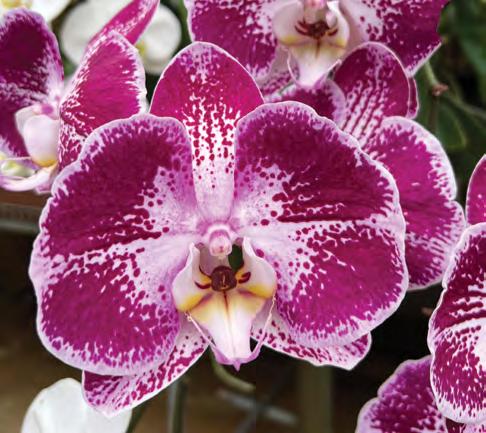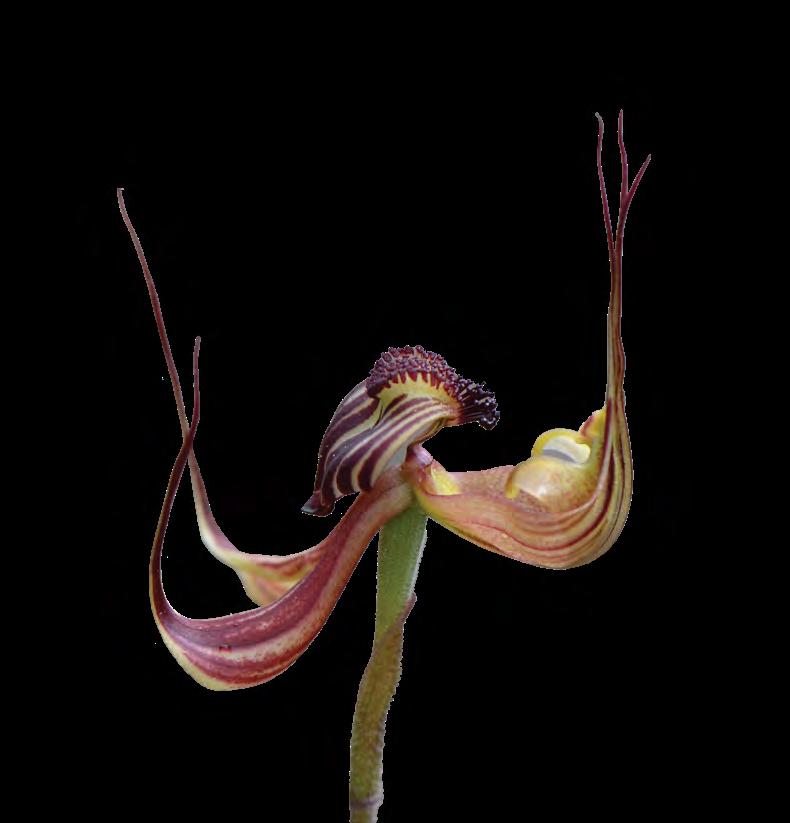
3 minute read
The enchanting world of orchids
Whether admired in the wild, showcased in botanic gardens, or carefully tended in home collections, orchids continue to enchant and inspire, writes John Siemon, Director Horticulture and Living Collections.
Orchids are among the most captivating and diverse plants on Earth, with around 28,000 species found in almost every corner of the world. The Orchidaceae family is the second-largest plant family, only beaten by the Asteraceae (daisy) family.
Advertisement
From the misty cloud forests of South America to the sun-drenched savannas of Africa, these botanical marvels have adapted to thrive in extraordinary environments. Beyond their sheer beauty, orchids tell a fascinating story of evolution, survival and human obsession.
One of the most mesmerising aspects of orchids is the variety of shapes, sizes and colours. Some, like Cattleya, boast ruffled petals and dazzling hues of purple and gold. The diversity of orchids ensures no two species are quite the same, making them a favourite among collectors and horticulturists.
Orchids are not just beautiful – they are cunning. Many species have evolved to mimic the appearance and scent of female insects, luring unsuspecting pollinators into a deceptive trap. Other orchids produce intoxicating fragrances that attract specific pollinators, ensuring their continued reproduction. Vanilla planifolia is the only orchid with edible fruit, as the pods are used for vanilla flavourings and scents. The Royal Botanic Garden Sydney has a number of specimens of this prized and endangered species.
Throughout history, orchids have captivated botanists, explorers, and plant enthusiasts. During the 19th century, a phenomenon known as ‘orchid fever’ swept through Europe, with wealthy collectors paying exorbitant sums for rare specimens. Today, while many orchids are cultivated in nurseries, conservationists work tirelessly to protect wild populations from habitat destruction and illegal collection.
Despite their reputation for being delicate, many orchids can be surprisingly easy to grow. Species like Phalaenopsis, or the Moth Orchid, thrive in indoor environments with indirect light and regular watering. The key to success lies in mimicking their natural conditions – using well-draining bark-based soil, maintaining humidity, and avoiding overwatering.
The Botanic Gardens of Sydney currently holds 906 species of orchids from South America, Asia, Pacific, Australia, Africa and many hybrid orchid cultivars. Our Living Collection holds representatives of 20 per cent of genera in the Orchidaceae family and is a key collection, representing almost 8 per cent of our total species. The majority of orchid specimens are held in the Royal Botanic Garden Sydney, many off public display, in two climate-controlled glasshouses, representing tropical and montane environments.
More than 50 of our specimens are listed on the International Union for Conservation of Nature (IUCN) conservation list with seven species critically endangered and eight endangered. In the Tropical collection we currently house approximately 1,600 individual plants. The most represented species are Dendrobium and Bulbophyllum, followed by Coelogyne, Vanda, Epidendrum, and Phalaenopsis. In the Montane Orchid House, we have around 500 individual specimens, with key species including Masdevallia, Dracula, Cymbidium, Pescatoria, and Restrepia
The orchid conservation program, located at the Australian Botanic Garden Mount Annan’s Australian PlantBank and Nursery, has a full-time scientific officer, Dr Zoe-Joy Newby, and a technical officer, Daniel Kovicz. The team, funded through the Saving our Species program, is currently working on thirteen species across five main projects, including the Willawarrin Doubletail (Diuris disposita) from the hinterland of the mid-north coast and the Lowly Rustyhood (Pterostylis despectans) from the Murray region of southern NSW.
Conservation efforts include annual populations monitoring, pollinator studies, hand pollination, seed collection and storage, propagation and Living Collection maintenance. Dr Newby’s work includes attempting to grow the Eastern Underground Orchid (Rhizanthella spp.) for detector dog training, and micropropagation (a form of tissue culture), of Calochilus, as germination from seed, to date, has proved extremely challenging.
Maintaining the perfect environment for these delicate plants is challenging. Temperature, humidity, light and nutrition must all be carefully calibrated, and with the changing seasons, this task becomes more complex. Through the generosity of the Foundation & Friends of the Botanic Gardens’ Growing Friends program a brand-new fogging system has been donated to the Royal Botanic Garden Sydney Nursery. This system will significantly improve the curation and care for the tropical orchid collection. Fifty-two high-pressure, fully adjustable nozzles now distribute a micro-fog increasing humidity without wetting the foliage, creating the ideal conditions for our orchids.
The resilience, beauty, and evolutionary brilliance of orchids makes them treasures of the natural world. Through your support we can continue to contribute to global plant conservation initiatives for orchids and all the other incredible jewels in our Living Collections.
To find out more about orchids, follow our Senior Horticulturist Valeriu Pintilie on social media
@Sydney_orchids_R
@valeriurazvanpinti














